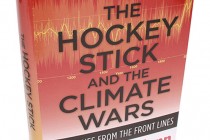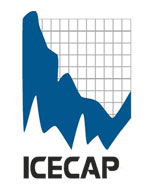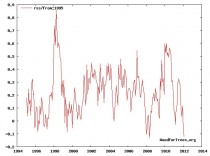By Anne Jolis, Wall Street Journal
The “Hockey Stick” is shorthand for two ways of thinking about global warming. For anti-carbon crusaders, a 1998 paper and its 1999 follow-up showing temperatures over the past 1,000 years demonstrated the terrible and immediate threat that man poses to the planet. (A graph accompanying the paper was nicknamed the “hockey stick,” as it shows a sharp upswing in the 20th century.) For global-warming skeptics, though, the graph and the name are prime examples of the overblown claims and sloppy science behind much of climatology.
Michael Mann, a Penn State professor, was the lead author of those studies, which became famous in 2001 when they were included in an assessment report by the United Nations Intergovernmental Panel on Climate Change (IPCC). He has since become one of the loudest advocates of the anti-carbon agenda, energetically blogging and tweeting about the need for urgent U.S. emissions reduction and global cap-and-trade. It’s not surprising that he is also a prime target for global-warming skeptics, who argue that establishing statistically significant temperature trends from proxy data is tricky and that Mr. Mann’s certainties involve, at best, debatable speculations and questionable math.
“The Hockey Stick and the Climate Wars” is the story of both Mr. Mann and his graph. But rather than a chronicle of research and discovery, it’s a score-settling with anyone who has ever doubted his integrity or work: free-market think tanks, industrialists, “scientists for hire,” “the corruptive influence of industry,” the “uninformed” media and public. So, a long list.
The trouble, as Mr. Mann sees it, is that while his own errors have been honest and minor, his detractors’ amount to “disinformation.” “Given the complexities,” he writes, “it’s easy enough to make mistakes. For those with an agenda, it is even easier to overlook them or, worse, exploit them intentionally.” He writes that the legitimate scientific and mathematical quibbles are compounded by “the here-and-now incentive” of the media. “Incremental refinements may seem dull and uninspiring to the lay public, but controversy sells… It is not difficult to see why confused observers attempting to follow scientific developments would throw up their hands, resigned to the notion that all we can safely conclude is that ‘the scientists don’t agree.’ “
Thus through the combination of fossil-fueled machinations and a public that can’t handle the nuance, Mr. Mann and the truth have become victims of the “most malicious of the assaults on climate science.”

The Hockey Stick and the Climate Wars, By Michael E. Mann, (Columbia, 395 pages, $28.95)
Yet in its treatment of the actual science, “The Hockey Stick” is structured not unlike IPCC reports. Mr. Mann synthesizes selected work in the field and carefully accounts for uncertainties - the shortcomings of climate modeling, the statistical pitfalls of paleoclimatology, the unknowns surrounding the role of clouds - before lapsing into sound bites: “The key question is, can the model be shown to be useful? Can it make successful predictions? Climate models had passed that test with flying colors by the mid-1990s.”
And like IPCC reports, checking endnotes and references is crucial. In his chapter “Climate Science Comes of Age,” Mr. Mann writes that there was “increasing recognition by the mid-1990s” that another 1.5C (2.5F) warming beyond current levels “could represent a serious threat to our welfare.” It turns out that “increasing recognition” refers to a benchmark agreed to by a group of EU ministers in 1996, which Mr. Mann cites along with his own 2009 paper.
The book’s climax is a recounting of the 2009 leak or hack of emails and other documents written by Mr. Mann and his associates (and funneled through the University of East Anglia’s Climatic Research Unit). The correspondence, along with a second trove released in 2011, highlighted the patchwork behind IPCC science. The leading lights of publicly funded climatology appeared to be brainstorming to pressure journals and review boards to suppress work that challenged their theories, trading tips on how to avoid public-information requests and planning how to present their findings so as to best further “the cause.”
In his book, Mr. Mann dubs the unauthorized release of his emails a “crime” and claims that the ensuing “witch hunt” constituted “the most malicious” of “attack after vitriolic attack against us” by the “corporate-funded denial machine.”
Yet for all his caviling about “smear campaigns,” “conspiracy theorists” and “character assassination,” Mr. Mann is happy to employ similar tactics against his opponents. Patrick Michaels, former president of the American Association of State Climatologists and a past program chair of the American Meteorological Society’s Committee on Applied Climatology, is introduced as “a prominent climate change contrarian at the University of Virginia primarily known for his advocacy for the fossil fuel industry.” (Nowhere does Mr. Mann explain why a scientist might be more easily corrupted by a check from, say, a coal company than by one from a politically controlled institution.)
Just this February, Mr. Mann took to the Daily Kos to praise the theft of internal documents from the free-market Heartland Institute for offering “a peek behind the curtain of industry-funded climate change denial.” It was revelatory, but not in the way he thought. Hours after Mr. Mann posted his online musings, the much-decorated hydroclimatologist Peter Gleick (2003 MacArthur fellow, adviser to the EPA and, until recently, chairman of the American Geophysical Union’s task force on scientific ethics) confessed to the Heartland theft. Apologizing for his actions, he wrote that he had been “blinded by my frustration with the ongoing efforts - often anonymous, well-funded, and coordinated - to attack climate science and scientists.”
Mr. Mann closes “The Hockey Stick” with a passionate call for more scientists to join him “on the front lines of the climate wars.” “Scientific truth alone,” Mr. Mann writes, “is not enough to carry the day in the court of public opinion.” It would be “irresponsible,” he says, “for us to silently stand by while industry-funded climate change deniers succeed in confusing and distracting the public and dissuading our policy makers from taking appropriate actions.” These are unfortunate conclusions for a scientist-turned-climate-warrior whose greatest weakness has always been a low estimation of the public intellect.
Miss Jolis is an editorial page writer for The Wall Street Journal Europe.
Update: in TWTW newsletter from SEPP, an excellent weekly newsletter, they note this story but say if you remove the two El Ninos the lack of warming is more like a decade. I would add, remove the 0.5C cooling 1991 to 1995, the lack of warming is going on even longer than 17 years.
By Steve Goddard
In 2003, Ben Santer of Lawrence Livermore Labs wrote:
LIVERMORE, Calif. - In order to separate human-caused global warming from the “noise” of purely natural climate fluctuations, temperature records must be at least 17 years long, according to climate scientists.
To address criticism of the reliability of thermometer records of surface warming, Lawrence Livermore National Laboratory scientists analyzed satellite measurements of the temperature of the lower troposphere (the region of the atmosphere from the surface to roughly five miles above) and saw a clear signal of human-induced warming of the planet.
Separating signal and noise in climate warming
Well here is the 17 year plot of global temperatures from the IPCC’s offical source, the Hadley Center.
Temperatures have been dropping since 2005, and are the coldest now in the last seventeen years. Game over for alarmists, based on their own rules.
----------------
The latest research belies the idea that storms are getting more extreme
Dr. Harold Brooks of the National Severe Storms Laboratory in a seminar at Penn State University addressed his ongoing research that deals with the connection between severe weather and climate change. He made the following points:
1. The large variability from one severe weather season to another, combined with ever improving and easier ways of reporting severe weather, make it difficult to link severe weather and climate change.
2. Significant severe weather (tornadoes and hail storms) depend more on wind shear (change in direction of strong winds with height) rather than a combination of heat and high humidity. Shear also determines the intensity of hail and tornadoes in the U.S. and Europe. Big tornado years have hail storms as the dominant secondary severe weather events (as opposed to just damaging winds).
3. Climate models projecting a future warmer world with C02 doubled show an increase in heat and humidity, but a decrease in shear (a decrease in equator to pole gradient).
4. These high heat/humidity & low shear environments result in little overall change in severe thunderstorms. However, there may be a slight decrease in tornadoes due to less shear and an increase in significant thunderstorm straight-line wind events due to an increase in heat and humidity.
By the way, Dr. Brooks also mentioned that the downward trend in tornado deaths since the 1920’s has leveled off over the past 30 years because of an increase in people living in mobile homes.
Indeed as we have noted this situation was driven by strong shear and large instability from a very cold upper atmosphere and a sun warmed lower air. Dewpoints were actually unusually low across the area north of the Tennessee Valley. They rose during the day in the Gulf into the Tennessee Valley, areas to the north the severe weather developed in drier air than is typical with severe activity this strong. By the way, the record for March tornadoes occurred in 1976 at the start of three incredibly cold winters.
By Roger Pielke Jr., Pielke Jr. Bog
There is seemingly a bottomless well of nonsense on disasters and climate change. I have long ago accepted that such nonsense is, like the presence of arguments rejecting the basic science of climate change, a situation to be lived with rather than changed. Even so, I can still poke some fun.
Climatewire reports uncritically a claim coming from Swiss re that “the financial toll of global weather disasters amounts to between 1 and 12 percent of U.S. gross domestic product annually.” This totals $160 billion to almost $2 trillion.
Reality Check: The actual number for global losses as a percent of US GDP is closer to 0.1%, with the maximum about 1.2% in 2005. The total cost of all hurricanes since 1900 in normalized dollars is about $1.4 trillion. The media (in general) rarely question numbers given to them from the reinsurance industry and on disasters and climate change have a strange aversion to the peer reviewed scientific literature. Innumeracy.
NOAA Administrator Jane Lubchenco and NCDC head Tom Karl write in Physics Today about the 14 “billion dollar disasters” tabulated by NOAA for 2011 and ask “Why did we see such expensive damage last year?” Their answer, predictably, includes “climate change” and is followed by a lengthy exposition on why NOAA needs more money.
Reality Check: Lubchenco and Karl somehow failed to note that NOAA and NCDC have cautioned against drawing any such conclusions from the “billion dollar disasters.” And even though Lubchenco and Karl cite the recent IPCC Special Report on Extreme Events, they also somehow forgot to mention this part: “Long-term trends in economic disaster losses adjusted for wealth and population increases have not been attributed to climate change, but a role for climate change has not been excluded.” Deceiving.
Swiss Reinsurance and the Reinsurance Association of America teamed up yesterday with a few US Senators to call for the US government to adopt policies to protect their industry from extreme events resulting from climate change. They also ite the NOAA billionz analysis and explain via press release “"From our industry’s perspective, the footprints of climate change are around us and the trend of increasing damage to property and threat to lives is clear,” said Franklin Nutter, president of the Reinsurance Association of America.”
Reality Check: The ability of the reinsurance industry to accurately reflect the state of the science of disasters and climate change has long been questionable. The industry is currently awash in money, a condition that Guy Carpenpter characterized just a few months ago as “the reinsurance sector remains adequately capitalized with a significant excess capital position” (PDF). In such a context, when reinsurers ask the government to take on some of their risks justified by “climate change,” you should hold tight to your wallet. Conflicted.
For anyone who is interested in the actual science of disasters and climate change, I’ll be speaking on the subject later today here at CU (for others, just have a look at TCF, chapters 7 and 8).



